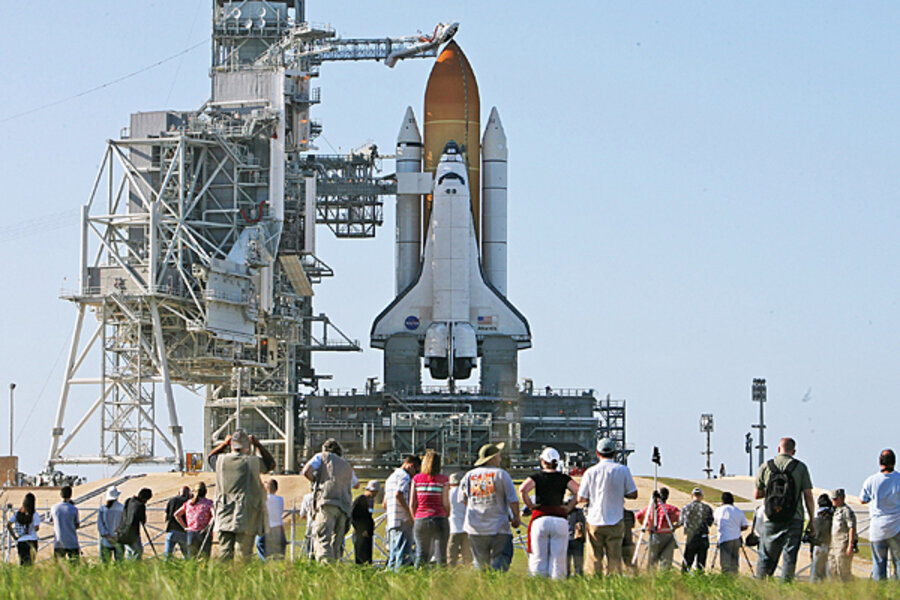Will this be final flight for space shuttle Atlantis? Maybe not.
Loading...
The space shuttle Atlantis and its six-member crew are set for launch Friday afternoon for a 12-day mission to the International Space Station – the final planned launch for Atlantis in the waning months of the space-shuttle program.
On its return, Atlantis will be treated as though it's headed into space one more time. It is the assigned rescue vehicle for the National Aeronautics and Space Administration's final shuttle mission, currently slated for November.
In principle, that preparation would also make the venerable orbiter available for one more flight. That's something many members of the Atlantis preparation team at the Kennedy Space Center would like to see from a vehicle that has traveled through only about one-third of its design life.
IN PICTURES: NASA's Space Shuttle
"I know there's a lot of hope that we get another flight," says Michael Leinbach, the mission's lead flight director. "But there's also a lot of realism that's not the plan right now."
Riding history
The sense of nearing a historic turning point in the US human spaceflight program is not lost on Atlantis's crew, either.
It's difficult to spend much time thinking about the wider significance of the mission "because we're right in the middle of it, with our nose down to doing the operation," acknowledges British-born mission specialist Piers Sellers.
But, he adds, the remaining orbiters are just as technologically significant to the spaceflight era as 18th-century naval vessels such as the USS Constitution or the HMS Victory were to maritime history.
"These three surviving shuttles, they're pieces of history," he says.
During the crew's 12-day stay at the International Space Station, their tasks would appear to be a bit more mundane than those performed during the heady days of heavy construction some 212 miles above Earth.
Atlantis is carrying a Russian-built module that will double as lab space and storage, as well as a fourth docking port for the country's Soyuz spacecraft. The module, dubbed Rassvet (Dawn), will arrive at the station loaded with supplies.
Three spacewalks
In addition, the shuttle crew will perform three spacewalks.
The first involves installing a spare space-to-ground communications antenna on the station, installing a platform designed to hold spare parts for the station on Dextre (a two-armed robot used for station maintenance), and loosing bolts in preparation for a second space walk two days later.
Spacewalk No. 2 aims to replace three of six batteries tied to one of the station's solar arrays – a task mission specialist Michael Good says has earned him some familial ribbing.
"I have four brothers, and one of my brothers likes to give me a hard time about flying up in space and changing batteries; he thinks this is not a very difficult task," he says.
But, he explains, "These aren't double-As.... These are 400-pound nickel-hydrogen batteries. They're the size of a very big suitcase, probably bigger than the airlines would let you take on without charging you extra."
Dr. Good, who took part in two spacewalks last May to repair and refurbish the Hubble Space Telescope, will be hefting the oversize Energizers to and from a platform at the end of a fully extended robotic arm.
The final spacewalk takes place two days later, with its specific tasks up in the air until the night before. The goal is to replace the remaining three batteries for the same solar array.
Far from mundane, "this is a very exciting mission," says John Shannon, the shuttle program director.
With space walks, cargo transfers, battery replacements, docking a Russian module, delivery of spare parts, and a large helping of robotic-arm activity, the mission "has a little bit of everything," he says.
That "everything" also includes hundreds of small items the agency as well as the astronauts are taking to space, including:
- Flags and embroidered patches the agency and several of its centers will give out as presentation items.
- A tan teddy bear for a medical foundation.
- A Cub Scout flag from Houston.
- A banner from Cohasset High School in Massachusetts, the alma mater oc mission specialist and US Navy Capt. Steve Bowen.
For the recipients of these bits of shuttle memorabilia, it's a chance to touch something that for 12 days was a part of human-spaceflight history.
IN PICTURES: NASA's Space Shuttle
Related:





